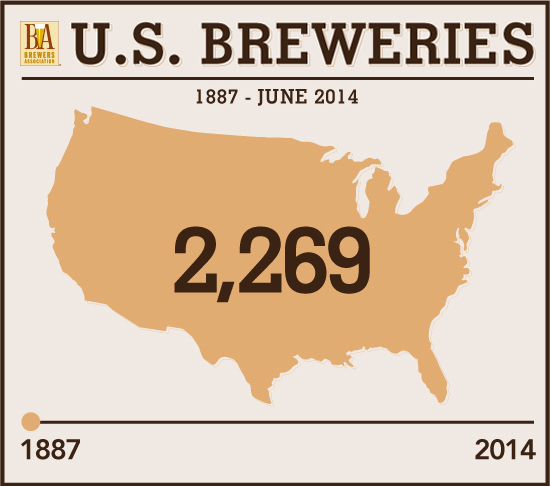![]()
I know that many people seem tired of celebrating numerical achievements, preferring to concentrate on the beer itself, or the quality of beers, etc., but I think there is something to be said for the continuing rise of the sheer number of breweries in America. It is, I believe, indicative of greater consumer acceptance and a desire for beer drinkers to want to support local producers. It’s true that the growth of the regional, larger breweries are fueling a lot of the marketshare, but with many of the new small breweries catering to a very local customer base, this growth phase we’re in shouldn’t slow down for a least a little while longer.
Yesterday, the Brewers Association announced that the number of breweries in the United States eclipsed 3,000, as of June 2014 stood at 3,040. Here’s more from the BA’s press release:
The American brewing industry reached another milestone at the end of June, with more than 3,000 breweries operating for all or part of the month (3,040 to be precise). Although precise numbers from the 19th century are difficult to confirm, this is likely the first time the United States has crossed the 3,000 brewery barrier since the 1870s. Wieren (1995) notes that the Internal Revenue Department counted 2,830 “ale and lager breweries in operation” in 1880, down from a high point of 4,131 in 1873.
What does 3,000 breweries mean? For one, it represents a return to the localization of beer production, with almost 99% of the 3,040 breweries being small and independent. The majority of Americans live within 10 miles of a local brewery, and with almost 2,000 planning breweries in the BA database, that percentage is only going to climb in the coming years.
Secondly, it means that competition continues to increase, and that brewers will need to further differentiate and focus on quality if they are going to succeed in a crowded marketplace. While a national brewery number is fairly irrelevant without understanding local marketplaces, 3,040 breweries could not happen without increased competition in many localities.
What it does not mean is that we’ve reached a saturation point. Most of the new entrants continue to be small and local, operating in neighborhoods or towns. What it means to be a brewery is shifting, back toward an era when breweries were largely local, and operated as a neighborhood bar or restaurant. How many neighborhoods in the country could still stand to gain from a high-quality brewpub or micro taproom? While a return to the per capita ratio of 1873 seems unlikely (that would mean more than 30,000 breweries), the resurgence of American brewing is far from over.


Great news, great perspective on it.
“Locals” (assuming they’re making quality product) never can be wrong – that one’s able to find them in unlikely places when traveling makes it even better! Mine (Elevation 66, El Cerrito, CA) will be celebrating its 3rd anniversary 9/1 – it’s a mile from my house, & I’ve been a “regular” since day 2 & have made many friends there amongst the other “regulars”. Good beer, good food, & good people serving it up – can’t get any better than that!
KUDOS to all the small craft brewers who keep jacking up the numbers – may your grains & hops keep flowing @ reasonable cost forever, & may your yeast remain pure!